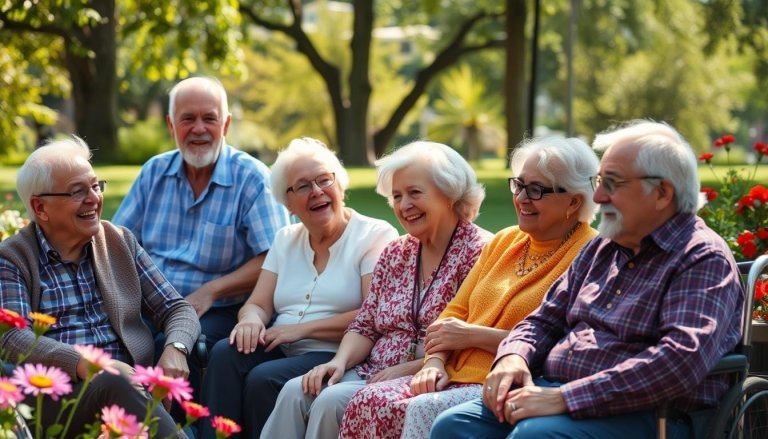Learning USA greetings is crucial for social interactions in America. Whether it’s your first time saying hello or you’re refreshing your skills, knowing American salutations is important. It shows you understand the culture and are good at socializing.
In the United States, how you greet people changes based on where you are. A firm handshake and eye contact are key in work settings. But, saying “What’s up?” is perfect with friends. Different places have their own ways of greeting, adding to the fun.
Always remember, a friendly smile is essential for a good first impression. As you learn more about USA greetings, keep in mind Americans like their space. Standing about a foot apart is common when talking. This guide will help you greet people the right way, whether it’s for fun or work.
Understanding USA Greetings and Cultural Context

Greetings are very important in American culture. They help set the mood for social interactions. How people greet each other varies across the country, showing the diversity of US society. Let’s look at the different ways of greeting in the USA.
The Importance of First Impressions in American Culture
In the US, making a good first impression is key. A firm handshake and direct eye contact are important when meeting someone new. People usually keep about 18 inches apart for friends and 4 feet for strangers. Knowing about personal space is crucial for a good first impression.
Regional Differences in American Greetings
How people greet each other can change by region. In the South, you might hear “Howdy” as a greeting. In many places, “Hey” is common. The Northeast is more formal, while the West Coast is laid-back with greetings.
Business vs Social Greeting Etiquette
Business greetings in the USA are more formal than social ones. In work settings, being on time is important. Greetings often include titles like “Mr.” or “Ms.” Social greetings are more relaxed, with phrases like “What’s up?” or “How’s it going?” being common. Knowing these differences helps you navigate different social situations in America.
| Setting | Typical Greeting | Body Language |
|---|---|---|
| Business | “Good morning, Ms. Johnson” | Firm handshake, direct eye contact |
| Social | “Hey! How’s it going?” | Casual wave or nod |
| Regional (Southern) | “Howdy, y’all!” | Friendly smile, relaxed posture |
Common Verbal Greetings and Expressions
Americans greet each other in many ways. From formal hellos to casual “hey-there’s,” the USA has a rich variety of greetings. Let’s explore the polite US expressions and learn to say hi like a true American!
Formal Greetings for Professional Settings
In business, using the right greetings is key. Say “Good morning,” “Good afternoon,” or “Good evening.” For emails, “Dear Mr. Smith” or “Dear Dr. Johnson” is best. Being formal shows respect in work settings.
Casual Everyday Greetings
In daily life, Americans use relaxed greetings. Say “Hey,” “Hi,” or “What’s up?” For a cool vibe, try “Yo” or “Sup?” These greetings make interactions with friends and others feel easy.
Time-specific Greetings
In the USA, greetings change with the time. Say “Good morning” until noon, “Good afternoon” from noon to 6 PM, and “Good evening” after 6 PM. These greetings are common and show you’re aware of the time.
Follow-up Phrases and Responses
After saying hello, Americans often ask, “How are you?” or “How’s it going?” Say “I’m fine, thank you” or “Good, thanks.” Remember to use “please” and “thank you” often. It’s a sign of good manners in the USA.
| Greeting Type | Examples | Usage |
|---|---|---|
| Formal | “Good morning,” “Greetings” | Professional settings |
| Casual | “Hey,” “What’s up?” | Friends, daily interactions |
| Time-specific | “Good afternoon,” “Evening!” | Any situation, shows time awareness |
| Follow-up | “How are you?” “How’s it going?” | After initial greeting |
Body Language and Physical Greetings in American Culture
Physical greetings in the USA are very important. They mix words and body language. Knowing these can make you feel more at ease in social situations.
In work settings, a firm handshake is key. It’s paired with direct eye contact, showing confidence and respect. People usually keep a certain distance when talking.
With friends, you might see hugs or back pats. Kissing as a hello is not common in the US. It’s nice to say hello to everyone in the room when you walk in.
- Thumbs up: Shows approval or agreement
- Nodding: Indicates understanding or encouragement
- Waving: Used for greetings or catching attention
- High five: Celebrates success or achievement
Body language is very telling in American talks. Arms crossed might mean you’re uncomfortable. An open stance means you’re ready to talk. The ‘OK’ sign and peace sign are good signs. But facepalming shows you’re upset or surprised.
Remember, greetings can change based on where you are. In cities like Los Angeles or Miami, you might hear “¡Hola!” along with “Hello.” Native American communities have their own special ways of saying hello, showing their culture.
Conclusion
Learning American greetings is key for getting along in the USA. Knowing how to greet people can make a big difference. From formal handshakes to casual “hellos,” greetings change a lot.
Email greetings are important today. With lots of emails coming in, picking the right one matters. Personalized greetings can help get more responses. Choosing the right sign-off shows you care.
Remember, American greetings show the country’s diverse culture. Different places and situations have their own rules. Knowing these helps you fit in better in the USA.



